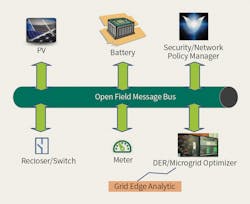Today, approximately 120 megawatts of customer-owned distributed energy resources, almost all rooftop photovoltaic systems, are spread out over 20,000 connections at various customer locations throughout Entergy Corp.’s system. Approximately 83.5 MW of utility-scale solar generation is currently in operation, and additional solar generation is under development. The company’s distributed energy resources exist in variations, including utility-scale, utility-owned, behind-the-meter and customer-owned solutions. The incorporation and improved visibility into and management of DERs is key to the utility’s approach to providing increased resiliency to customers in higher-risk weather-prone areas, such as New Orleans, Louisiana, U.S.
Change & Growth
As DERs and new technology appear in increasing numbers on the grid, they are changing customer expectations for reliability and service. They are also challenging grid operations as the company juggles the impacts of new assets, particularly those that are customer-owned or third-party-owned at the grid’s edge. Fortunately, these assets often are intelligent and can be remotely controlled assuming that communications can be addressed as well as access rights. This distributed intelligence capability creates opportunities to co-optimize and integrate the operation of both utility- and customer-owned assets. Co-optimization requires enhanced telecommunications, cybersecurity and distributed analytics to manage rapidly changing bidirectional power flows.
To do this effectively, Entergy is implementing centralized and distributed analytics while enhancing cybersecurity. Together, these steps should help to transform the utility’s customer experience. However, to respond to customer needs and continue providing safe, affordable and reliable power, Entergy also identified the need to transform how it thinks about DERs. Entergy is now involved in industry-leading efforts to support a more interoperable approach to deploying system components. It supports the shift to data-centric technology connecting software applications to the data, and not to each other. Entergy feels this is a more effective way to implement systems to support distributed generation, distributed storage, energy efficiency and demand response at a greater scale than currently seen.
Needs
Today, most software systems used to manage operation of the grid are point-to-point, integrated with each other on an as-needed basis to support a specific function or set of functions. Introducing another software application into daily operations typically involves also implementing and maintaining another set of integrations to other related applications. As such, the complexity of coordinating, maintaining and securing this bundle of operational systems grows exponentially with the number of points that require integration.
This approach makes it difficult to manage a variety of information technology and operational issues associated with operating the grid, including the following:
- Incorporation of new supply-side and demand-side assets
- Security of assets and systems
- Interoperability of differing vendor devices and systems
- Upgrading assets in the field
- Certification of assets and operations
- Optimization of systems and assets
- Routing and quality of service
- Incorporation of new languages and platforms.
Data-Centric Approach
Entergy is evaluating an alternate approach that involves the use of a data bus, a common location where data is made available and applications “subscribe” to the data to use it, for the integration of disparate devices and systems. This approach satisfies the desire to implement data-centric sharing and filtering of data. Implemented correctly, it supports an any-to-any interoperability architecture that should offer more reliability and scalability, quality-of-service control, the potential for automatic discovery, no use of servers or brokers, improved security and the ability to interconnect systems developed in very different environments such as C, C++, Java, Python, LabVIEW and others.
New Orleans Solar Power Project
This is the focus of an evaluation project taking place at Entergy’s New Orleans solar power plant. This is a combined solar and battery storage pilot facility. Built on approximately 15 acres (6.07 hectares) of company-owned property, it interconnects to the rest of the Entergy system at 13.2 kV and has been in service since June 2016.
The project deployed grid edge analytics at the solar plant site with the following configuration of assets:
- 1.08-MWAC of ground-mounted solar with single-axis tracking
- Two 600-kVA inverters
- 500-kWh 1-hr Li-ion battery
- Solar inverter (APIS system) with Modbus communications enabled
- Battery storage (APCS system) with Modbus communications enabled.
The work to date represents an initial phase to place analytics at the grid edge to analyze grid behavior as well as the output of the solar and battery assets. The solution uses Open Field Message Bus compliant protocols installed in a station computer, a Schweitzer Engineering Laboratories Inc. SEL-3355. Data monitoring was enabled through OpenFMB software through Docker software set up on the SEL-3355, which is connected to the Entergy operations and information technology network. A jump server/remote desktop connection was made into the SEL-3355. The OpenFMB software and Docker technology collects data from the Modbus protocol-based addresses and registers to obtain operational data for monitoring the DER output, solar inverter and battery controller performance. Grafana, a web browser-based tool, was used to display the electrical quantities.
The installed Open Field Message Bus allows for the publishing of periodic readings along with data-driven events in near-real time.
The Framework
The OpenFMB interoperability framework is a standard ratified in 2016 by the North American Energy Standards Board. It enables traditional grid edge operational assets and DERs — such as solar photovoltaics, energy storage systems and microgrids — to communicate quickly and securely with each other in the field regardless of each device’s local communications protocols. This interoperability framework will help the energy grid to operate more efficiently — delivering better performance to customers and grid operators alike.
The OpenFMB facilitates federated deterministic exchanges of data between assets. Periodic readings are then published on the message bus every few seconds providing a near-real time reading. Data-driven events also are published based on a change in status in near-real time. The readings obtained include real and reactive power per phase, voltage and current per phase, phase angle relationships, power, time stamps and state of charge. Primary event-related messaging involves trips and openings along with the associated time stamps. The system also is set up to perform grid edge analytics, determining specifics around the state of the assets such as the battery.
Use of Grid Battery Storage to shift the peak solar generation to periods of peak load and help produce a steady power output from utility scale solar generation. Utilities need to ensure that their batteries are capable of handling frequent charging and discharging cycles triggered by OpenFMB based grid-edge analytics for control of DER sites’ power output.
Remote monitoring of solar and battery power through OpenFMB application on an on-site computer.
Future State
Currently, the logic engine and dispatch capability are unique to the Entergy New Orleans solar power plant. The dispatch is not dynamic, based on changing real-world priorities, and the dispatch solution is not scalable. The evaluation project work is intended to create a desired future state that represents a commercial yet customizable optimization and dispatch solution capable of reading weather, load and other inputs as well as reprioritizing based on real-time and forecast set points. The desire is to ensure priorities and functional modes can be set outside of the distribution operation center (DOC) while the DOC still maintains system protection and reliability. The desire also is to ensure the logic and integration are scalable and more easily modified for future DER installations.
The application of distributed intelligence to DERs is expected to provide several benefits. From a distribution system perspective, this approach can accelerate the response to address local system needs such as voltage, capacity, rerouting power and so forth. It also should improve battery use, balancing the cost of degradation versus benefit of power and energy per cycle. This approach also should improve response to real-time and forecast inputs such as weather, price and load. Perhaps most important for Entergy, this approach can help form the basis to design a repeatable solution for future projects.
Stakeholder Participation
From a dispatch and analytics perspective, the approach provides an improved graphical user interface for setting desired operational modes, leading to better value for the DOC. It also provides better access to historical data for analytics and lessons learned. Additionally, it can affect improved interoperability with other present and future distribution assets and systems such as and advanced distribution management system and outage management system.
Entergy has engaged a broad set of support resources from within and outside the utility as work has been undertaken to create a new approach to a better DER-based grid. Several acceptance groups participated in dealing with the Entergy information technology and operations technology infrastructure, represented by the company’s substation services, data networking engineering, data security and telecom groups.
Deployment groups were formed to support Entergy technology and analytics composed of the utility’s customer product engineering and data analytics groups as well as external support from Open Energy Solutions Inc. Operations and maintenance groups supporting Entergy power generation included distribution maintenance, fossil and renewables, the Entergy Residential Rooftop Solar Pilot program and additional vendors for solar and battery technology.
Several nontechnical lessons were learned during this initial effort. It was critical to work with all stakeholders early on and for all to understand the planned use cases. Preparing for change management was also important. Testing in a lab environment helped to build confidence in the new approach. The need became clear to develop process and methodologies for repeatable projects. Entergy also learned it could leverage existing assets in the system with this new approach.
Next Steps
Initial feasibility efforts are underway and being applied in the field, actively monitoring solar and storage assets with embedded OpenFMB software in commercially available hardware. Planned next steps are to coordinate with internal stakeholders to develop expanded project plans; make use of a nonproprietary OpenFMB message bus and standard protocols such as data distribution service; federate, secure and communicate an expanded set of vital data; and use the system to enable further grid edge analytics.
Entergy also is seeking to expand the integration with IEC 61850, an international standard defining communication protocols for intelligent electronic devices at electrical substations, and other strategic protocols and interfaces. In addition, the utility plans to enhance the platform so it automatically controls, dispatches and manages the existing solar and battery storage at the Entergy New Orleans solar power plant and develop more analytic tools to analyze grid behavior and optimize the output of the solar and battery assets. This approach creates a solution that will be replicable across the Entergy system for the smart control and dispatch of DERs.
Acknowledgement
The authors would like to thank Shreyas Pawale and Ben Byboth of Entergy Services; Seth Cureington of Entergy New Orleans; Larry Lackey and Cory Nguyen of Open Energy Solutions Inc.; and Erik Felt of Real Time Innovations for their support of this effort.
For more information:
Entergy | www.entergy.com
About the Author
S. Cat Wong
S. Cat Wong is the manager, customer product engineering for Entergy Corp. She leads the planning, design and implementation activities of Distributed Energy Resources at Entergy, which includes PV, battery storage and microgrids. She has 18 years of industry experience in the integration of DERs, PMU deployment, transmission and distribution planning, protection analysis and standards development. She has BSEE and MSEE from the Hong Kong Polytechnic University and Ph.D. from Tulane University and is a Registered Professional Engineer and Professional Project Manager.



